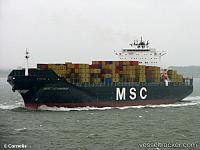 The fire on the containership MSC Flaminia, abandoned in the mid-Atlantic after a fire and explosion on July 15th, is reported now to be under control. The ship is under by the Smit salvage tug Fairmount Expedition at five knots and is roughly 320 NM off the coast of the the UK. The tugs Anglian Sovereign and Carlo Magno remain on standby. The Anglian Sovereign has been monitoring temperatures aboard the ship and will resume cooling as necessarily. The ship and tugs are now in dense fog. Once viability improves, a salvage team will go aboard the ship and inspect for burning containers and extinguish any fires found.
The fire on the containership MSC Flaminia, abandoned in the mid-Atlantic after a fire and explosion on July 15th, is reported now to be under control. The ship is under by the Smit salvage tug Fairmount Expedition at five knots and is roughly 320 NM off the coast of the the UK. The tugs Anglian Sovereign and Carlo Magno remain on standby. The Anglian Sovereign has been monitoring temperatures aboard the ship and will resume cooling as necessarily. The ship and tugs are now in dense fog. Once viability improves, a salvage team will go aboard the ship and inspect for burning containers and extinguish any fires found.
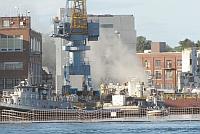
Photo:Elizabeth Dinan/www.seacoastonline.com
We apologize to industrial vacuum cleaners. (They may not be the national security threat we once thought.) In a previous post we repeated a statement by the Federal investigators that the fire on the nuclear submarine USS Miami, undergoing repairs in the Portsmouth Naval shipyard was caused by an industrial vacuum cleaner.
Yesterday, Casey James Fury, a 24 year old shipyard painter and sandblaster, was charged with arson for setting the May 23rd fire, which did $400 million damage to the submarine. He is reported to have said that he set the fire so that he could get off work early. He admitted to using a cigarette lighter to ignite a vacuum cleaner and a pile of rags on the submarine. Fury is also charged with setting a second fire in June in the dry dock next to the USS Miami. Fury was said to be taking a variety of medications for anxiety, depression, allergies and insomnia at the time of the first fire. If convicted on either charge, Fury could face life in prison. The Navy has not yet determined whether it will repair or scrap the $900 million USS Miami. Thanks to Alaric Bond and Irwin Bryan for contributing to the post.
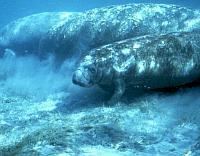 Drivers on the Courtney Campbell Causeway began calling the authorities to report manatees in trouble. There appeared to be around ten manatees on a sandbar not far from the causeway that connects Tampa and Clearwater, Florida. Drivers stopped their cars and pulled over to get a better look. Police called the Clearwater Marine Aquarium and their experts said the mammals were not in distress. They were mating. As the crowd of onlookers grew, police officers cordoned off the waterline with crime scene tape to give the manatees some privacy. This is not the first time that mating manatees have stopped traffic on the causeway. In 2004, an estimated 500 onlookers tied up traffic as a group of manatees frolicked just offshore in 2 to 3 feet of water. Video of the manatees after the break.
Drivers on the Courtney Campbell Causeway began calling the authorities to report manatees in trouble. There appeared to be around ten manatees on a sandbar not far from the causeway that connects Tampa and Clearwater, Florida. Drivers stopped their cars and pulled over to get a better look. Police called the Clearwater Marine Aquarium and their experts said the mammals were not in distress. They were mating. As the crowd of onlookers grew, police officers cordoned off the waterline with crime scene tape to give the manatees some privacy. This is not the first time that mating manatees have stopped traffic on the causeway. In 2004, an estimated 500 onlookers tied up traffic as a group of manatees frolicked just offshore in 2 to 3 feet of water. Video of the manatees after the break.
Mating manatees cause a stir on Courtney Campbell in Clearwater
Continue reading
This seems like a suitable video for a Monday morning. Tres Hombres is a Dutch 32 meter cargo-carrying brigantine, meant to serve as an ambassador to a new fleet of sustainable hybrid sailing vessels. The video below is beautifully shot footage of the Tres Hombres under sail set to soothing music. What better way to start the week than watching a beautiful ship under sail on open sea?
A very interesting interview with Captain Denise Meagher and Dawn Santamaria of the schooner Unicorn and the Sisters under Sail Program at this weekend’s Halifax Tall Ships Festival.

This gallery contains 15 photos.
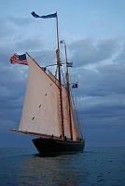 At the end of May, we posted about the “unfortunate economics of tall ships.” All ships, sailing ships included and perhaps, especially, are devilishly expensive to maintain and run, and income is tough to come by, especially in these difficult economic times. One of the examples we noted was the 126-foot schooner Virginia which had fallen on hard times in 2009. We are therefore immensely pleased to see that the schooner Virginia is back sailing, running educational programs to teach children about sailing, leadership and the importance of the Elizabeth River and why it should be protected. “Elizabeth River Adventures,” is a seagoing camp run jointly by the schooner Virginia, Nauticus and the Elizabeth River Project.
At the end of May, we posted about the “unfortunate economics of tall ships.” All ships, sailing ships included and perhaps, especially, are devilishly expensive to maintain and run, and income is tough to come by, especially in these difficult economic times. One of the examples we noted was the 126-foot schooner Virginia which had fallen on hard times in 2009. We are therefore immensely pleased to see that the schooner Virginia is back sailing, running educational programs to teach children about sailing, leadership and the importance of the Elizabeth River and why it should be protected. “Elizabeth River Adventures,” is a seagoing camp run jointly by the schooner Virginia, Nauticus and the Elizabeth River Project.
The nonprofit Virginia Maritime Heritage Foundation raised money for new masts and rigging for the schooner and has formed a partnership with the museum, Nauticus, to take over the schooner’s operation. Last month, the Virginia served as an anchored mark in the Parade of Sail that opened OpSail. Now, it’s a highlight of the summer camp. And next year, the Virginia will pay a role in a new sailing center for disadvantaged youths. All we can say is “welcome back!”
 The Smit 16,320-hp ocean going tug Fairmount Expedition has reportedly been successful in controlling the spread of the fire on the MSC Flaminia, the 6,732 TEU container ship which was abandoned in middle of the North Atlantic last Sunday after suffering a fire and an explosion. The Fairmount Expedition was joined last night by a second salvage tug, the 16,500-hp Anglian Sovereign. A third tug, the 10,880-hp Carlo Magno, is expected to arrive around mid-day Sunday to assist with the firefighting.
The Smit 16,320-hp ocean going tug Fairmount Expedition has reportedly been successful in controlling the spread of the fire on the MSC Flaminia, the 6,732 TEU container ship which was abandoned in middle of the North Atlantic last Sunday after suffering a fire and an explosion. The Fairmount Expedition was joined last night by a second salvage tug, the 16,500-hp Anglian Sovereign. A third tug, the 10,880-hp Carlo Magno, is expected to arrive around mid-day Sunday to assist with the firefighting.
Smit’s salvage master has reported that the MSC Flaminia’s hull appears to be intact and that the deckhouse, engine room and after hatches do not appear to have been damaged by the fire and explosion. Nevertheless, he estimates that it could take several weeks to bring the fire under control. There are plans to board the ship this week end and to attempt to ship’s firefighting system.
Twenty survivors of the fire and explosion arrived in Falmouth yesterday aboard the VLCC DS Crown. Three injured crew were transferred to the container ship MSC Stella and are now being treated in the Azores. One crew member died in the explosion on the MSC Flaminia and one is still missing.
The 86′ schooner Larinda sank in Halifax harbor during Hurricane Juan on September 29, 2003. She was raised from the harbor bottom and following a nine year restoration has returned to Halifax for this year’s Tall Ship Festival.
The design and construction of the schooner are highly distinctive. The hull was modeled after HMS Sultana, a Royal Navy schooner built in the years prior to the American Revolution. The Larinda, however, is not quite a replica. The schooner has a 2,800-square-foot junk rig and the hull is built of ferro-cement. Also, below decks, the schooner is powered by a historic1928 eight ton 100 HP Wolverine diesel engine, thought to be one of only two still operating. From her frog figurehead to her broad stern, the Larinda is unique.

Lifeboat from the Mignonette
We recently posted in response to a video, “The Strangest Coincidence Ever Recorded?.” It recounted how three men named Hugh Williams were each the only survivors of shipwrecks in the treacherousness Menai Straits off North Wales. More remarkably, two of the Hugh Williams escaped from shipwrecks on the same day, December 5th separated by over a hundred years. The video claimed that all three Hugh Williams’ ships sank on December 5th, but that was not the case. And Hugh Williams is a very common name in North Wales, so while it is a remarkable coincidence, it doesn’t quite rank as the “strangest ever recorded.”
On the topic of nautical coincidences, Chris Quigley at the Quigley’s Cabinet blog, mentioned the Mignonette coincidence. All that we can say is, Hugh Williams meet Richard Parker. The case of Richard Parker and the Mignonette does indeed involve coincidence but the story remains compelling because it raises issues of morality that are very tricky to address, even to this day.
 Last September we posted about the sinking of a ferry off Zanzibarwith the loss of 200 passengers. Yesterday, another ferry sank off the Zanzibar coast. Thirty eight are confirmed dead with another 100 missing. Zanzibar police spokesman Mohamed Mhina said, “Search operations continue but it is now almost impossible survivors will be found… The ship has completely sunk. There were 290 people on board.”
Last September we posted about the sinking of a ferry off Zanzibarwith the loss of 200 passengers. Yesterday, another ferry sank off the Zanzibar coast. Thirty eight are confirmed dead with another 100 missing. Zanzibar police spokesman Mohamed Mhina said, “Search operations continue but it is now almost impossible survivors will be found… The ship has completely sunk. There were 290 people on board.”
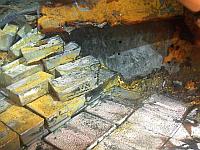
Photo: Odyssey Marine
Last September we posted that Odyssey Marine Exploration had located the wreck of the S.S. Gairsoppa, which was torpedoed in February of 1941 by a German U-boat. When she sank, the ship was loaded with 240 tonnes of silver believed to be worth approximately $200 million (around £155 million.) Yesterday the company announced that, so far, they have recovered approximately 48 tonnes of silver worth roughly $38 million. The wreck lies almost three miles below the surface and is one of the most valuable and deepest ship wrecks ever salvaged. Salvage operations are expected to continue through September. Under a salvage contract with the British government, Odyssey will keep 80% of the proceeds after expenses.
Odyssey Announces First Load of Silver Cargo from Three Miles Deep
Continue reading
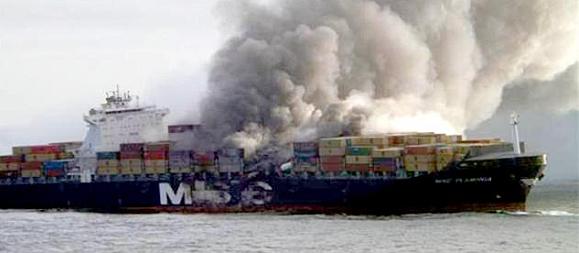 On Sunday we posted about an explosion and fire aboard the container ship MSC Flaminia in the North Atlantic about a thousand miles west of Cornwall. The first officer died from burns received in the fire and one crew member is missing. The rest of the 25 crew were evacuated and the ship was abandoned. Now, four days later, the ship is burning and new explosions have been reported. The first firefighting tug, the Smit Fairmont Expedition, has arrived at the drifting ship. The new explosions interrupted the tug’s firefighting operations. A second firefighting tug is expected to arrive today.
On Sunday we posted about an explosion and fire aboard the container ship MSC Flaminia in the North Atlantic about a thousand miles west of Cornwall. The first officer died from burns received in the fire and one crew member is missing. The rest of the 25 crew were evacuated and the ship was abandoned. Now, four days later, the ship is burning and new explosions have been reported. The first firefighting tug, the Smit Fairmont Expedition, has arrived at the drifting ship. The new explosions interrupted the tug’s firefighting operations. A second firefighting tug is expected to arrive today.
From photographs sent back, it appears that the fire has spread through at least five stacks of containers, or close to 220′ along the length of the 980′ ship. So far, the engine room, deck house and after hatches do not appear to be on fire. The container ship Hanjin Ottowa is also standing by to help assess the situation aboard the burning ship.
Correction: Based on local news reports, we originally posted that water pressure from the steamer Portland‘s paddle-wheel damaged the Royaliste. We were incorrect. The Portland clearly backed into the ketch, which was tied up alongside the dock. See the video below, which shows the impact. Thanks to Captain Larsen and Robert Kennedy for pointing out our error and to Alaric Bond for forwarding the video of the collision.
Friday, June 13th, should have been a great day at the first St. Helen’s Maritime Heritage Festival for both the 55′ privateer ketch Royaliste and the 186′ historic stern-wheel steamer Portland. Both ships were making debuts of a sort. The Royaliste has been undergoing extensive restoration for several years and her first public re-appearance was last Friday. Likewise, the sternwheeler Portland, built in 1949 and owned by the Oregon Maritime Museum, was carrying its first passengers down the Columbia River since a mechanical failure nearly sent it plummeting over the Bonneville Dam in 2008.
Unfortunately, things did not go well when the vessels crossed paths. The Royaliste was at the dock when the Portland came backing down. The sternwheeler’s rail struck the ketch’s starboard side, opening several seams in the ketch’s planking. (See the video below.) The Royaliste immediately began taking on water and was saved from sinking by portable pumps provided by U.S. Coast Guard and the Columbia County Sheriff’s Office marine unit. According to its Facebook page, the Royaliste has made it back to its home port in Schooner Creek and is being kept afloat by pumps pending the arrival of the insurance surveyors.
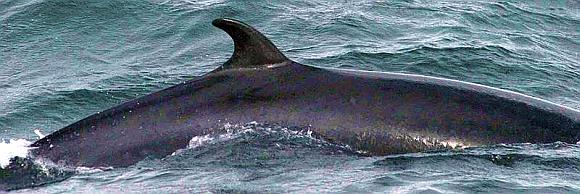 When Korea announced plans, earlier this month, to resume whaling for “scientific purposes” it was hit by a tsunami of protests from environmental groups and nations around the world. France, the United States, Australia and New Zealand in particular spoke out strongly against the Korean plan. Korea planned to exploit the loophole provided for “scientific whaling for research” in Article VIII of the whaling convention.
When Korea announced plans, earlier this month, to resume whaling for “scientific purposes” it was hit by a tsunami of protests from environmental groups and nations around the world. France, the United States, Australia and New Zealand in particular spoke out strongly against the Korean plan. Korea planned to exploit the loophole provided for “scientific whaling for research” in Article VIII of the whaling convention.
Yielding to diplomatic pressure from countries around the world, Korea has now scrapped its plan to resume whaling. South Korea has banned commercial whale hunting since 1986, but allows the sale of meat from whales accidentally caught in fishing nets. Norway and Iceland are the only two countries who engage in commercial whaling. Japan engages in whaling for “research,” which critics argue is merely a pretense to provide cover for commercial whaling. Thanks to Phil Leon for passing along the news.
On a fog-shrouded Tuesday, the schooner Unicorn was the first to arrive in Halifax for their Tall Ships Festival. In addition to being a lovely topsail schooner, the Unicorn is the only tall ship sailing in the world with an entirely female crew. The schooner is host to the “Sisters Under Sail Program.” Founded by Dawn Santamaria, the program introduces young women to tall ship sailing, directed by a professional all-female crew. Last year, Dawn Santamaria was honored with the 2011 Leadership In Women’s Sailing Award at the National Women’s Sailing Association Conference, in Marblehead, MA for the Sisters Under Sail program. Thanks to Linda Collison for passing along the news.
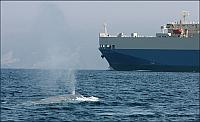
Photo/John Calambokidis, Cascadia Research
One of the greatest threats to many endangered species of whale is being run down by ships or getting entangled in fishing nets. This week, federal maritime officials have approved a plan to protect whales in and around San Francisco Bay that features rerouting ship traffic and finding better ways to track whale locations. The new rules, which were developed working with the shipping industry, are in response to a dramatic increase in the number of deaths of migrating blue, fin and humpback whales due to being struck by ships. The whale species are all endangered and are believed to have been drawn closer to shore and into shipping lanes by an abundance of krill, the shrimp-like organisms that the whales eat.
Falls of Clyde is the last four-masted full-rigged iron ship and the only surviving sailing oil tanker. The ship was launched in 1878 in Port Glasgow, Scotland, for the Fall Line. She became a museum ship in Honolulu, Hawaii in 1971, but was never properly maintained. In 2008, the Bishop Museum, which had control of the ship, was preparing to tow her out sea and scuttle her. In September 2008, the Friends of Falls of Clyde, a non-profit group of volunteers, saved the ship by acquiring it, and has been attempting to raise money to drydock, repair and begin the restoration of the long-neglected historic ship.
It has not been easy going. The organization has secured $350,000 from the Robert J. Pfeiffer Foundation, and was hoping to receive another half million dollars from the Federal preservation program, “Save America’s Treasures.” Unfortunately, Congress in its wisdom, or lack thereof, cut funding for the program. The volunteers of the Friends of Falls of Clyde are determined to carry one. To learn more about the ship click here. To donate to help save the Falls of Clyde, click here.
 There is a video bouncing around the web these days called “The Strangest Coincidence Ever Recorded?” (The video is embedded at the bottom of the post.) It tells the story of a ship which sank in the Menai Strait off the coast of Wales on December 5, 1664. All 81 passengers died, except one. His name was Hugh Williams. Then on December 5th, 1785 another ship with 60 aboard sank in the Menai Strait. The only survivor – a man named Hugh Williams. In 1820 on December 5th, a third vessel sank in the Menai Strait. All 25 aboard were drowned except, you guessed it, a man named Hugh Williams.
There is a video bouncing around the web these days called “The Strangest Coincidence Ever Recorded?” (The video is embedded at the bottom of the post.) It tells the story of a ship which sank in the Menai Strait off the coast of Wales on December 5, 1664. All 81 passengers died, except one. His name was Hugh Williams. Then on December 5th, 1785 another ship with 60 aboard sank in the Menai Strait. The only survivor – a man named Hugh Williams. In 1820 on December 5th, a third vessel sank in the Menai Strait. All 25 aboard were drowned except, you guessed it, a man named Hugh Williams.
An amazing tale, but is it history or just a an oft retold sea story? It could easily be a bit of each.
 The container ship, MSC Flaminia, is in flames, drifting in the North Atlantic, roughly half way between Britain and Canada, approximately 1,000 miles west of Cornwall. One man is reported either be missing or to have died from burns. At least three others were injured in an attempt to fight a fire and explosion which broke out in a container in the No. 4 hatch on Saturday. MSC Flaminia is a 6,732 TEU post-Panamax ship, registered in Germany and built in 2001. The ship’s crew of 25 abandoned ship and was picked up in a lifeboat and liferaft by the VLCC DS Crown. The injured crew were transferred to the container ship MSC Stella, which is carrying them to the Azores for treatment. The burning ship is beyond the range of rescue helicopters. Tradewinds reports that oceangoing salvage tugs may have been dispatched to fight the fire.
The container ship, MSC Flaminia, is in flames, drifting in the North Atlantic, roughly half way between Britain and Canada, approximately 1,000 miles west of Cornwall. One man is reported either be missing or to have died from burns. At least three others were injured in an attempt to fight a fire and explosion which broke out in a container in the No. 4 hatch on Saturday. MSC Flaminia is a 6,732 TEU post-Panamax ship, registered in Germany and built in 2001. The ship’s crew of 25 abandoned ship and was picked up in a lifeboat and liferaft by the VLCC DS Crown. The injured crew were transferred to the container ship MSC Stella, which is carrying them to the Azores for treatment. The burning ship is beyond the range of rescue helicopters. Tradewinds reports that oceangoing salvage tugs may have been dispatched to fight the fire.
